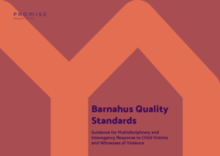Drawing on international and European law and guidance and the Barnahus model, this document introduces ten good practice standards, the “European Barnahus Standards”, for multidisciplinary and interagency services for child victims and witnesses of violence in Europe adapted to the child. The key purpose of the standards is to provide a common operational and organisational framework that promotes practice which prevents retraumatisation, while securing valid testimonies for Court, and complies with children’s rights to protection, assistance and child-friendly justice.
The standards are a collection of cross-cutting principles and activities, core functions and institutional arrangements that enable child-friendly, effective and coordinated interventions, including: 1.1 Best interests of the child; 1.2 Children’s rights to be heard and receive information; 1.3 Preventing Undue Delay; 2. Multidisciplinary and Interagency Organisation; 3. Target Group; 4. Child-friendly environment; 5. Interagency planning and case management; 6. Forensic Interviews; 7. Medical Examination; 8. Therapeutic services; 9. Capacity building and; 10. Prevention: Information sharing and external competence building.
A core purpose of the standards is to ensure that measures are put in place to prevent retraumatisation of child victims and witnesses of violence. By practising in accordance with the standards, retraumatisation can be prevented, since it involves ensuring that the best interest of the child informs practice and decisions; that the right of the child to be heard is fulfilled without repetitive interviews; that the child is interviewed and supported by specialised and competent professionals; that interviews are carried out in a multidisciplinary environment in one child-friendly premise, offering adequate support to the child and care-givers without undue delay and; that the child is not obliged to appear in Court.
The standards are inspired by previous work in this area, including the Standards for Accredited Child Advocacy/Protection Centres of the National Children’s Alliance in the USA and the criteria developed for evaluation of Barnahus in Sweden. They have been developed with the input from experienced experts and practitioners from Barnahus and child-friendly centres working with child victims and witnesses of violence in Europe. They are based on what has been demonstrated to work and have genuine added value for the child, the family and the professionals working together.
Importantly, the standards embody a model to fulfil legal obligations set out in European and international law. International and European law typically require general principles, such as best interests of the child and child participation, to be observed and they also contain certain specific provisions concerning key processes, such as interviews with child victims and assistance provided to them. The standards correspond to how these legal provisions can be implemented in day to day practice through cross cutting activities and core functions of the Barnahus. The standards also address the institutional arrangements which underpin the practice, and although these are more rarely provided for in the law itself, they are addressed in authoritative guidance on implementing these laws. In short, the institutional arrangements describe ways of working that enable teams to maximise their ability best to fulfil the legal provisions.
The standards have been formulated to ensure transferability and adaptability, recognising that they will be implemented in different political, legal, judicial, socio-economic and cultural contexts. Each standard is illustrated by examples of noteworthy practice from prominent Barnahus and child-friendly services in Europe, displaying how different types of services and national contexts have generated different approaches while keeping to the fundamental principles, activities and arrangements outlined in the standards.
In adopting the standards, it should be noted that it is important continuously to assess and evaluate the organisational set-up and performance of the service. The indicators attached to the standards provide some examples of information that reveal if the standards are met, and to what extent, and eventually supports review of policy and practice. Evaluation also provides important opportunities to ensure that new research, guidance, law and experience inform the practice and set-up of the service. Special efforts should be made to ensure that children are heard and that their views inform the set-up of the service.
Other resources related to the Barnahus Model include:
- Standard 2 - Multidisciplinary & Interagency Collaboration: Interagency Agreement Template and Guidance
- ChildHub and Promise Webinar Series: Formal Agreements and the Daily Work of Multidisciplinary Interagency Cooperation
- Webinar: 20 years of Barnahus – Featuring Bragi Gudbrandsson
- Webinar: Adapting the Barnahus concept to local realities
- Introduction to Therapeutic Services at the Barnahus (Childhub and Promise Webinar)
- Webinar: PROMISE Child Participation Tool
- Webinar: Law as one enabling factor
- Webinar: Working together in the best interests of the child: discussions on the formal agreements and the daily work of multidisciplinary interagency cooperation

